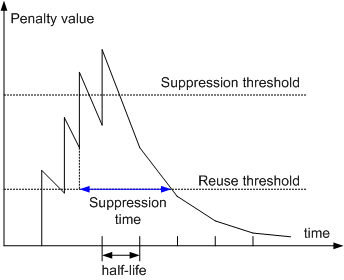Route Dampening
When BGP is used on complex networks, route flapping occurs frequently. To prevent this, BGP uses route dampening to suppress unstable routes.
Route flapping is a process of adding a route to an IP routing table and then withdrawing this route. When route flapping occurs, a BGP device sends an Update message to its neighbors. The devices that receive the Update message need to recalculate routes and modify routing tables. Frequent route flapping consumes lots of bandwidths and CPU resources and even affects normal network operation.
Route dampening measures the stability of a route using a penalty value. A larger penalty value indicates a less stable route. In Figure 1, each time route flapping occurs, BGP increases the penalty of this route by a value of 1000. When the penalty value of a route exceeds the suppression threshold, BGP suppresses this route, and does not add it to the IP routing table or advertise any Update message to peers. After a route is suppressed for a period of time (half-life), the penalty value is reduced by half. When the penalty value of a route decreases to the reuse threshold, the route is reusable and is added to the routing table. At the same time, BGP advertises an Update message to peers. The suppression time is the period from when a route is suppressed to when the route is reusable.
Route dampening applies only to EBGP routes but not IBGP routes. IBGP routes may include the routes of the local AS, and an IGP network requires that the routing tables of devices within an AS be the same. If IBGP routes are dampened, routing tables on devices are inconsistent when these devices have different dampening parameters. Therefore, route dampening does not apply to IBGP routes.
